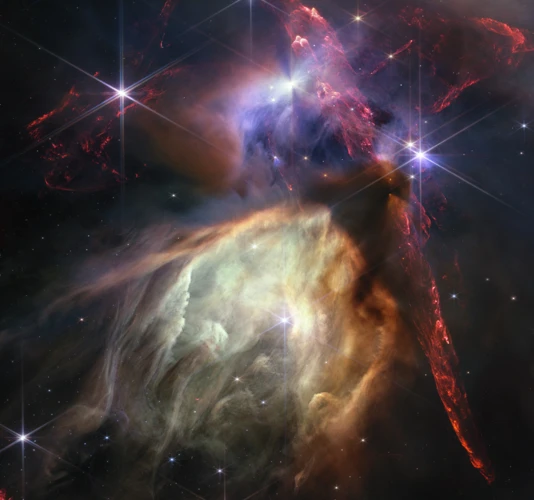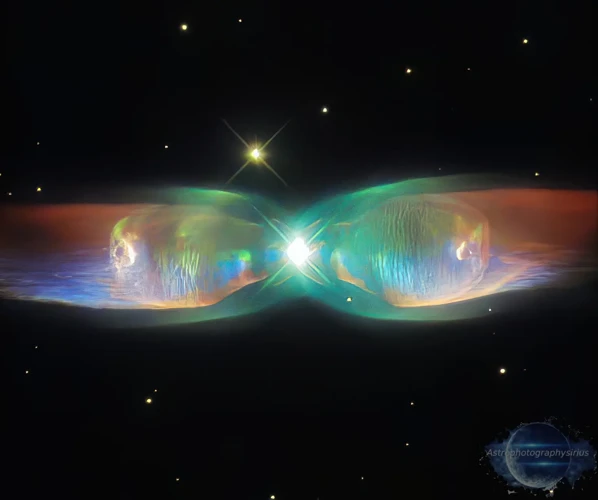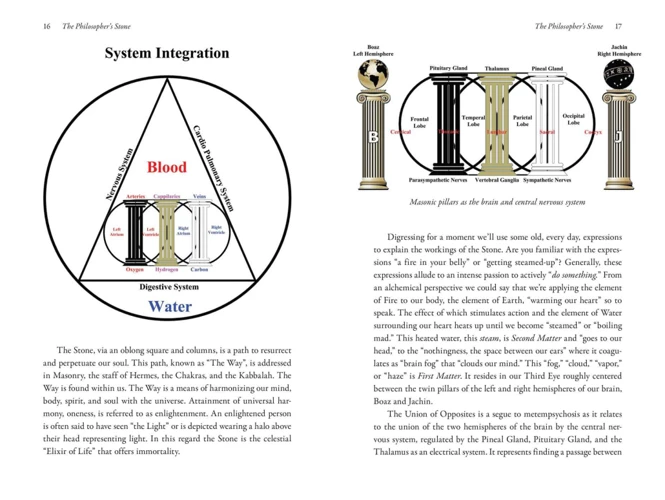The Mysterious Crab Nebula: Unraveling the Enigma of the Cosmos
A dazzling spectacle in the night sky, the Crab Nebula has captivated astronomers and stargazers for centuries. This cosmic wonder, located in the Taurus constellation, remains shrouded in mystery, tantalizing with its celestial beauty and intricacies. Delving into the depths of the universe, we embark on a journey to uncover the mysteries of the Crab Nebula, exploring its birth, unraveling its perplexing features, uncovering the quest for understanding, and pondering its implications and significance. Join us as we peer into the wondrous unknown, seeking to illuminate the enigmatic secrets of the cosmos.
Contents
- The Birth of the Cosmic Enigma
- Unraveling the Nebula’s Features
- The Quest for Understanding
- Implications and Significance
- Conclusion
-
Frequently Asked Questions
- What causes the Crab Nebula’s unique appearance?
- When did the supernova event that formed the Crab Nebula occur?
- What is a pulsar and why is it significant within the Crab Nebula?
- How far away is the Crab Nebula from Earth?
- What is the significance of the Crab Nebula in our understanding of stellar evolution?
- How do astronomers study the Crab Nebula?
- What other celestial objects can be found within the Taurus constellation?
- Can the Crab Nebula be seen with the naked eye?
- Are there any ongoing collaborative efforts dedicated to studying the Crab Nebula?
- Could the Crab Nebula hold clues to unlocking the secrets of the universe?
- References
-
Frequently Asked Questions
- 1. What is the Crab Nebula?
- 2. How did the Crab Nebula form?
- 3. What makes the Crab Nebula glow?
- 4. What are the filaments in the Crab Nebula?
- 5. What are the ghostly remnants in the Crab Nebula?
- 6. How is technology used to study the Crab Nebula?
- 7. What observatories and instruments are used to study the Crab Nebula?
- 8. How do scientists collaboratively study the Crab Nebula?
- 9. What insights does the Crab Nebula provide into stellar evolution?
- 10. What potential future discoveries can be made in studying the Crab Nebula?
- References
- Read More
The Birth of the Cosmic Enigma

The Crab Nebula, a cosmic enigma etched in the vast expanse of the universe, has a birth story that continues to perplex and astound astronomers. At the heart of this enigmatic spectacle lies the remnants of a supernova, a cataclysmic explosion that marked the grand finale in the life of a massive star. Astrologically speaking, the Crab Nebula’s origin resonates with the ambitious nature of Capricorn, as it represents the culmination of a star’s journey and the birth of a stellar phenomenon. This supernova explosion released an extraordinary amount of energy, creating shockwaves that hurled matter into the surrounding space. However, the story didn’t end there. Within the violent aftermath, a remarkable cosmic engine emerged – a pulsar. This pulsar, known as a neutron star, spins incredibly fast, emitting beams of radiation that sweep across the cosmos. The birth of this pulsar within the Crab Nebula adds another layer of intrigue to this cosmic enigma, elevating its mystique to new heights.
A Supernova’s Last Breath
A supernova’s last breath marks the culmination of a massive star’s life, releasing a cataclysmic explosion that reverberates across the cosmos. The Crab Nebula’s story begins with the death throes of such a star, as it exhausts its nuclear fuel and collapses upon itself. The tremendous gravitational forces at play cause the star’s core to collapse, triggering an explosive chain reaction that blasts its outer layers into space. This monumental event is marked by an intense burst of energy, illuminating the surrounding interstellar medium with an awe-inspiring display of light and radiation. As the remnants of the supernova expand outward, they create shockwaves that interact with the surrounding gas and dust, forging complex structures and sculpting the nebula’s intricate features. This celestial fireworks show, capturing the very essence of a doomed star’s finale, becomes a permanent testament to its incredible power and transience. To witness the last breath of a supernova is to observe the birth of a cosmic enigma, one that continues to captivate astronomers and unlock the secrets of the universe.
The Birth of a Pulsar
One of the most fascinating aspects of the Crab Nebula is the birth of a pulsar at its core. When the supernova exploded, it left behind the remnants of its stellar core, which collapsed under its own gravity. The extraordinary compression and density during this collapse led to the formation of a pulsar, a highly-magnetized and rapidly-rotating neutron star. This pulsar at the heart of the Crab Nebula, known as the Crab Pulsar, spins at an incredible rate of over 30 times per second. Its magnetic field is immensely powerful, estimated to be a trillion times stronger than Earth’s magnetic field. This intense spinning and magnetic activity give rise to beams of radiation that emit from the pulsar’s magnetic poles. As the pulsar rotates, these beams sweep across space like a cosmic lighthouse, leading to periodic bursts of electromagnetic radiation that can be observed from Earth. The discovery and understanding of pulsars within the Crab Nebula have provided invaluable insights into the nature of highly-compact stars, gravitational collapse, and the immense power associated with these cosmic phenomena. Studying the pulsar in depth has allowed scientists to explore the mysteries of physics and delve into the intricacies of the universe. The enigmatic nature of the Crab Pulsar and its profound impact on our understanding of the cosmos make it a focal point of research and a source of awe and wonder for astronomers and enthusiasts alike. Native American mythology reveres the concept of pulsars and the spiritual significance of celestial phenomena, offering a unique perspective when contemplating the birth of these cosmic entities.
Unraveling the Nebula’s Features

Unraveling the intricate features of the Crab Nebula leads us into a realm of cosmic wonders that defy comprehension. The nebula’s mesmerizing brilliance emanates from the ionized gases within its boundaries, creating a vibrant and ethereal glow that dances across the interstellar canvas. These ionized gases, consisting of hydrogen, helium, and other elements, reveal themselves through various spectral lines, each telling a unique story of elemental composition and energy distribution. Exploring the southern hemisphere constellations allows astronomers to observe the Crab Nebula in all its celestial glory, enabling a deeper understanding of its features and behaviors. The nebula showcases an intricate web of filaments, intricately intertwined like cosmic threads. These filaments, composed of matter ejected during the supernova explosion, continue to expand and evolve, leaving astronomers in awe of their delicate and intricate nature. Among the tapestry of filaments lie ghostly remnants of stellar debris, silent witnesses to the explosive event that gave birth to this enigmatic cosmic phenomenon. As we delve deeper into the mysteries of the Crab Nebula, we realize that the more we uncover, the more we are left in awe of the cosmic tapestry that unfolds before us.
The Brilliant Glow of Ionized Gases
Amidst the intricate tapestry of the Crab Nebula lies a breathtaking sight – the brilliant glow of ionized gases. These gases, predominantly hydrogen and helium, become energized by the intense radiation emitted by the pulsar at the heart of the nebula. This radiation strips electrons from the atoms, resulting in a state of ionization. As the electrons recombine with the ions, they release energy in the form of vibrant light, creating a mesmerizing display of colors. The ionized gases within the nebula emit predominantly in the red part of the electromagnetic spectrum, giving rise to the striking crimson hues that permeate its vast expanse. This radiant illumination is further enhanced by the interaction between the energetic particles and the surrounding magnetic fields, shaping the glowing gases into intricate structures that dance and swirl through space. The brilliant glow of ionized gases within the Crab Nebula leaves astronomers and astrophysics enthusiasts in awe, providing a captivating visual manifestation of the turbulent forces and processes that occur within the cosmos.
An Intricate Web of Filaments
Within the mesmerizing expanse of the Crab Nebula, an astonishing sight awaits astronomers – an intricate web of filaments weaving through the cosmic tapestry. These delicate filaments, composed mainly of ionized gases, stretch across vast distances, creating a mesmerizing spectacle of cosmic threads. The origins of these filaments are still shrouded in mystery, but scientists believe they are a result of the powerful shockwaves unleashed during the supernova explosion that birthed the nebula. Explorers of the southern hemisphere sky have marveled at the complexity and structure of these filaments, which resemble wispy strands that defy the traditional notion of cosmic material. Observations have revealed that these filaments are composed of charged particles, such as hydrogen and helium, that are being energized by the pulsar at the heart of the Crab Nebula.
These filaments, with their intricate patterns and intricate structure, continue to challenge astronomers with their puzzling behavior. They exhibit a range of characteristics, from glowing brightly in some regions to appearing dark and shadowy in others. The interaction between the filaments and the intense magnetic fields within the nebula is believed to play a significant role in shaping their form and behavior. Scientists are still trying to understand the precise mechanisms that give rise to the filamentary structure and how they are sustained over such long periods of time.
To study these captivating filaments up close, astronomers have employed a combination of ground-based observatories and space telescopes. High-resolution images captured by instruments such as the Hubble Space Telescope have allowed scientists to peer into the intricate details of the filaments, revealing their complex interconnections and providing clues about their formation. These observations have sparked numerous theories and hypotheses about the nature of the filaments, with some scientists speculating that magnetic fields and cosmic ray particles play significant roles in their creation and maintenance.
As our understanding of the Crab Nebula’s intricate web of filaments deepens, new questions arise. What causes the different regions of brightness and darkness within the filaments? How do these filaments evolve over time? What role do they play in the ongoing evolution of the nebula? These unanswered questions continue to inspire astronomers, driving them to uncover the secrets hidden within the enigmatic threads of the cosmic web.
Ghostly Remnants of Stellar Debris
The Crab Nebula is not just a pretty sight; it is also a graveyard of stellar remnants, with ghostly remains strewn across its celestial expanse. In the aftermath of the supernova explosion that birthed the nebula, the outer layers of the dying star were violently ejected into space, leaving behind a mesmerizing tapestry of material. These remnants consist of various elements and compounds, such as hydrogen, helium, and heavier elements synthesized in the star’s core through nuclear reactions. These remnants, referred to as supernova ejecta, are spread throughout the nebula and play a crucial role in understanding the star’s life cycle. The expanding shockwave from the supernova blast energizes and heats the surrounding debris, causing it to emit light in a beautiful display of colors. Brilliant filaments and knots of gas form intricate patterns, outlining the expanding shell of the nebula. Within these filaments, astronomers have detected molecules, organic compounds, and even exotic elements. The presence of these remnants provides a unique opportunity to study the elemental composition and physical processes that occur within dying stars, offering valuable insights into stellar evolution and the intricate workings of the universe. The ghostly remnants of stellar debris within the Crab Nebula continue to astonish and perplex scientists, fueling their insatiable quest for knowledge about the mysteries of the cosmos.
The Quest for Understanding

The enigmatic nature of the Crab Nebula has spurred a relentless quest for understanding among astronomers and scientists alike. Technology has played a pivotal role in unraveling the mysteries hidden within this celestial wonder. Powerful observatories and advanced instruments have allowed scientists to peer deep into the heart of the nebula, capturing detailed images and collecting invaluable data. These technological advancements have provided crucial insights into the formation and evolution of the Crab Nebula, shedding light on the processes that shape the universe. The quest for understanding the nebula has been a collaborative effort, bringing together experts from various fields and institutions who work tirelessly to unlock its secrets. The tireless dedication and collaboration among scientists have propelled our understanding of the Crab Nebula to new frontiers, fueling our curiosity and driving us closer to deciphering the cosmic enigma it holds.
The Role of Technology in Studying the Nebula
Technology plays a pivotal role in unraveling the secrets of the Crab Nebula, providing astronomers with powerful tools to observe and study this cosmic enigma. One such technological marvel is the advanced telescope systems that have revolutionized our understanding of the universe. These telescopes, equipped with high-resolution imaging sensors, allow scientists to capture detailed images of the nebula, revealing its intricate features and celestial phenomena. Through the use of spectroscopy, another technological breakthrough, researchers can analyze the light emitted by the nebula, deciphering its chemical composition and unraveling the intricacies of its ionized gases. Additionally, cutting-edge astronomical instrumentation, such as spectrometers and radio telescopes, enable scientists to measure the nebula’s electromagnetic emissions, collecting valuable data to map its structure and dynamics. The advent of computer technology has also been instrumental, allowing for complex simulations and data analysis to model the behavior and evolution of the Crab Nebula. By harnessing the power of technology, astronomers can enhance their understanding of this celestial wonder, opening doors to new insights and potential discoveries in the vast expanse of the universe.
Observatories and Instruments at the Forefront
When it comes to unraveling the mysteries of the Crab Nebula, observatories and cutting-edge instruments play a vital role in our quest for understanding. Astronomers have established a network of observatories around the globe, each equipped with advanced technology designed to capture the tiniest details of this celestial phenomenon. One such observatory is the Hubble Space Telescope, a powerhouse in space exploration that has provided breathtaking images and invaluable data about the Crab Nebula. Its high-resolution cameras and spectrographs have allowed scientists to study the nebula’s intricate structures and analyze the behavior of its ionized gases. Meanwhile, the Chandra X-ray Observatory has focused its gaze on the high-energy emissions emanating from the Crab Nebula, shedding light on the pulsar at its core. By capturing X-ray images, Chandra has revealed the pulsar’s powerful jets, which radiate outwards and interact with the surrounding nebula. On Earth, ground-based observatories like the Atacama Large Millimeter/submillimeter Array (ALMA) and the Very Large Array (VLA) have contributed to our understanding of the Crab Nebula by capturing radio waves and millimeter radiation. This multi-wavelength approach, combining observational data from various sources, allows astronomers to paint a comprehensive picture of the nebula’s intricate features and unravel its complex nature. With these observatories and instruments at the forefront of exploration, scientists continue to make groundbreaking discoveries that push the boundaries of our knowledge about the Crab Nebula.
The Collaborative Effort in Unraveling the Mystery
Unveiling the secrets of the Crab Nebula requires a collaborative effort from scientists, astronomers, and technological advancements. Researchers around the world come together, pooling their expertise and resources to study this cosmic enigma. Their collective dedication fuels the exploration of this celestial marvel, pushing the boundaries of human knowledge. Collaborative projects, such as the International Year of Astronomy, bring together scientists from different countries, fostering a spirit of cooperation and mutual understanding. Through partnerships and shared data, researchers can analyze and interpret the complex data collected from various observatories, satellites, and telescopes across the globe. This collaborative initiative enables scientists to piece together the intricate puzzle of the Crab Nebula, dissecting its features, unraveling its mysteries, and gaining deeper insights into the complexities of the universe. Interdisciplinary collaborations with experts from diverse fields, such as astrophysics, spectroscopy, and computational science, provide valuable perspectives and approaches that contribute to a comprehensive understanding of this cosmic enigma. By combining their knowledge, skills, and technologies, these collaborations propel the investigation of the Crab Nebula forward, inching closer to deciphering its enigmatic nature.
Implications and Significance

The implications and significance of the Crab Nebula reach far beyond its mesmerizing beauty. The study of this celestial phenomenon provides invaluable insights into the intricate process of stellar evolution. By observing the various stages that led to the creation of the Nebula, astronomers can deepen their understanding of how stars are born, live, and ultimately meet their explosive demise. The Crab Nebula serves as a window into the secrets of the universe itself. By unraveling its enigmatic features, scientists can unlock clues about the formation and dynamics of galaxies, the distribution of cosmic rays, and even the nature of dark matter. This cosmic marvel holds boundless potential for future discoveries, as it continues to amaze and perplex astronomers, reminding us of the vastness and complexity of the cosmos we inhabit.
Insights into Stellar Evolution
The Crab Nebula offers a unique window into the complex and fascinating process of stellar evolution. By studying this cosmic enigma, astronomers have gained invaluable insights into the life cycles of stars. Through the remnants of the supernova explosion and the birth of the pulsar, scientists have been able to trace the evolution of a massive star from its youthful, energetic phase to its explosive demise. The nebula’s intricate filaments and ionized gases provide clues about the mechanisms involved in the formation and dispersal of stellar matter. This wealth of information has allowed astronomers to refine and expand theoretical models of stellar evolution, deepening our understanding of the fundamental processes that shape the universe. Insights gained from studying the Crab Nebula have also shed light on the formation of other celestial objects, such as planetary nebulae and supernova remnants. Each discovery brings us closer to unraveling the mysteries of the cosmos and furthering our knowledge of the vast and ever-evolving universe.
Unveiling the Universe’s Secrets
Unveiling the Universe’s Secrets:
– Exploring Exoplanets: One of the most intriguing aspects of studying the Crab Nebula is the potential it holds for unraveling the secrets of exoplanets. By closely observing the formation and dynamics of stellar remnants within the nebula, scientists can gain valuable insights into the birth and evolution of planetary systems. This knowledge can help us better understand the conditions necessary for the emergence of habitable worlds and the potential for extraterrestrial life.
– Probing Stellar Evolution: The Crab Nebula provides a unique opportunity to study the different stages of stellar evolution. By analyzing the remnants of the supernova explosion and the behavior of the pulsar at its core, scientists can gain invaluable insights into the life cycles of massive stars. This knowledge helps us refine our understanding of how stars form, evolve, and ultimately meet their explosive fates. It also deepens our appreciation for the immense power and energy that stars possess.
– Unlocking the Mysteries of the Cosmos: The Crab Nebula serves as a celestial laboratory, allowing scientists to conduct experiments on a cosmic scale. By observing the interactions between high-energy particles, magnetic fields, and shockwaves within the nebula, researchers can simulate and study the physical processes that occur throughout the universe. This knowledge contributes to our broader understanding of astrophysics, enabling us to grasp the fundamental laws and principles that govern the cosmos.
– Furthering Technological Advancements: The study of the Crab Nebula pushes the boundaries of technological innovation. Scientists employ advanced telescopes, imaging techniques, and spectroscopy to capture and analyze the intricate details of the nebula. The development of cutting-edge technologies and methodologies in this field not only deepens our understanding of the Crab Nebula but also opens up new possibilities for studying and exploring other astronomical phenomena in the future.
As we continue to peel back the layers of this cosmic enigma, the Crab Nebula holds the promise of unlocking the universe’s deepest secrets. By delving into its mysteries, we gain valuable insights into exoplanets, stellar evolution, the fundamental workings of the cosmos, and the advancements of technology. The Crab Nebula serves as a constant reminder of the vastness and complexity of the universe, inspiring scientists and dreamers alike to embark on an eternal quest for knowledge.
Potential for Future Discoveries
The Crab Nebula, with its complex nature and ongoing evolution, holds immense potential for future discoveries in the field of astrophysics. As technology advances and observational techniques improve, scientists anticipate uncovering new insights into the intricate processes occurring within this cosmic enigma. Some of the potential areas of study and discovery include:
1. Supernova Remnants: Examining the Crab Nebula in greater detail may provide a deeper understanding of the remnants left behind by supernova explosions. By studying the composition and distribution of elements within the nebula, scientists can gain valuable insights into the life cycles and deaths of massive stars.
2. Pulsar Dynamics: The pulsar at the heart of the Crab Nebula continues to captivate scientists with its rapid spin and powerful magnetic fields. Future research aims to explore the dynamics of pulsars, unraveling the mysteries behind their emission mechanisms and the mechanisms responsible for their stability.
3. High-Energy Processes: The Crab Nebula is a rich source of high-energy radiation, including X-rays and gamma rays. The study of these energetic processes can shed light on the mechanisms that generate such extreme levels of energy and the interactions between particles within the nebula.
4. Supernova Triggering: The Crab Nebula’s supernova was a result of the explosive death of a massive star. By studying the conditions that led to the blast, scientists hope to gain a better understanding of the factors that trigger supernova events and the mechanisms that shape the resulting nebulae.
5. Multi-Wavelength Observations: Utilizing a wide range of observational methods across the electromagnetic spectrum, scientists can gather valuable data to piece together a comprehensive picture of the Crab Nebula. Future missions and telescopes will enable greater resolution and sensitivity, allowing for a more detailed exploration of the nebula’s properties.
The potential for future discoveries within the Crab Nebula remains vast, promising new insights into the nature of stellar evolution, the dynamics of pulsars, and the processes that shape our universe. As humanity’s understanding of the cosmos continues to grow, the enigmatic beauty of the Crab Nebula serves as a constant reminder of the vast mysteries and untapped knowledge that lie beyond our reach.
Conclusion

Conclusion:
In conclusion, the Crab Nebula continues to dazzle and perplex astronomers, enticing them with its cosmic beauty and mysteries. Through our journey into its birth, features, quest for understanding, and implications, we have gained valuable insights into the enigmatic nature of this celestial phenomenon. The relentless pursuit of knowledge and the advancements in technology have allowed us to delve deeper than ever before into the secrets of the universe. However, despite significant progress, the Crab Nebula still holds many unanswered questions. Its intricate filaments, ionized gases, and remnants of stellar debris serve as reminders of the vastness and complexity of the cosmos. As we forge ahead, it becomes clear that the exploration of the Crab Nebula is just the tip of the iceberg, offering a glimpse into the immense possibilities for future discoveries and revelations about the nature of the universe. With collaborative efforts, cutting-edge observatories, and innovative instruments, we continue to unveil the cosmic enigma that is the Crab Nebula while simultaneously unlocking the mysteries of the universe as a whole. As we peer into the night sky, we are reminded of the vast wonders that lie beyond, beckoning us to unravel their secrets and expand our understanding of the infinite cosmos.
Frequently Asked Questions

What causes the Crab Nebula’s unique appearance?
The Crab Nebula’s distinctive appearance is primarily due to the explosion of a massive star, known as a supernova. The remnants of the explosion, along with the high-energy particles and radiation produced, interact with the surrounding interstellar medium, creating the remarkable features we observe.
When did the supernova event that formed the Crab Nebula occur?
The supernova event that led to the formation of the Crab Nebula occurred in the year 1054 AD. The explosion was so bright that it was visible during the day for several weeks and left behind a celestial spectacle that has fascinated astronomers ever since.
What is a pulsar and why is it significant within the Crab Nebula?
A pulsar is a highly magnetized, rotating neutron star that emits beams of electromagnetic radiation from its poles. In the case of the Crab Nebula, the pulsar at its core spins rapidly, emitting powerful beams that can be observed across different wavelengths. This pulsar holds valuable insights into the extreme physics of compact stellar objects.
How far away is the Crab Nebula from Earth?
The Crab Nebula is located approximately 6,523 light-years away from Earth. This vast distance means that the light we observe from the nebula today actually left it over 6,500 years ago, showcasing a snapshot of its past.
What is the significance of the Crab Nebula in our understanding of stellar evolution?
The Crab Nebula serves as a crucial laboratory for studying stellar evolution. Its formation from a supernova explosion provides valuable insights into the later stages of a massive star’s life and the processes that drive its explosive demise. By analyzing the nebula’s structure and the behaviors of its pulsar, astronomers can deepen their understanding of the life cycles of stars.
How do astronomers study the Crab Nebula?
Astronomers study the Crab Nebula using a combination of ground-based telescopes, space-based observatories, and an array of instruments designed to capture and analyze different wavelengths of light. These observations allow scientists to explore the nebula’s structure, composition, and dynamics in great detail.
What other celestial objects can be found within the Taurus constellation?
The Taurus constellation is home to several notable celestial objects, including the Pleiades star cluster (also known as the Seven Sisters), the Hyades star cluster, the Taurus Molecular Cloud, and the distant galaxy NGC 1559. Exploring these neighboring objects provides astronomers with a broader context for understanding the Crab Nebula.
Can the Crab Nebula be seen with the naked eye?
Yes, the Crab Nebula can be observed with the naked eye under favorable viewing conditions. However, its dimness and relatively small size compared to other celestial objects make it more ideal for observation with telescopes or binoculars.
Are there any ongoing collaborative efforts dedicated to studying the Crab Nebula?
Yes, the study of the Crab Nebula involves collaborations among various research institutions and international observatories. Sharing of data, resources, and expertise enables scientists to pool their efforts and tackle the intricate mysteries of this cosmic enigma.
Could the Crab Nebula hold clues to unlocking the secrets of the universe?
Indeed, the Crab Nebula holds the potential to unlock many secrets of the universe. Its study provides valuable insights into astrophysical phenomena, stellar evolution, and the behavior of extreme cosmic objects. By deepening our understanding of the Crab Nebula, we can gain new perspectives on the nature and workings of the cosmos as a whole.
References
Frequently Asked Questions

1. What is the Crab Nebula?
The Crab Nebula is a cosmic marvel located in the constellation of Taurus. It is the result of a supernova explosion witnessed by astronomers in the year 1054, making it one of the most famous and studied objects in the night sky.
2. How did the Crab Nebula form?
The Crab Nebula formed when a massive star underwent a supernova explosion, releasing a tremendous amount of energy and creating a shockwave that expelled its outer layers into space. The remaining core collapsed, giving birth to a pulsar, a rapidly rotating neutron star.
3. What makes the Crab Nebula glow?
The brilliant glow of the Crab Nebula is primarily due to ionized gases, specifically hydrogen and helium, which emit a range of vibrant colors. These gases are energized by the intense radiation produced by the pulsar at the nebula’s center.
4. What are the filaments in the Crab Nebula?
The Crab Nebula contains intricate filaments, often described as a complex web. These filaments are thought to be the result of shockwaves generated during the supernova explosion. They are composed of ionized gas and dust, and their precise formation is still a subject of scientific investigation.
5. What are the ghostly remnants in the Crab Nebula?
The ghostly remnants within the Crab Nebula are the leftover debris from the supernova explosion that gave birth to the nebula. These remnants include the pulsar wind nebula, wisps of gas, and dust clouds. Studying these remnants helps scientists better understand the structure and dynamics of the nebula.
6. How is technology used to study the Crab Nebula?
Technology plays a vital role in the study of the Crab Nebula. Astronomers use advanced telescopes, including radio telescopes, X-ray observatories, and space-based instruments, to observe different wavelengths of light emitted by the nebula. They also utilize computer simulations and data analysis tools to unravel its intricate details.
7. What observatories and instruments are used to study the Crab Nebula?
Several prominent observatories and instruments are dedicated to studying the Crab Nebula. These include the Hubble Space Telescope, the Chandra X-ray Observatory, the Very Large Array (VLA), and the Atacama Large Millimeter/submillimeter Array (ALMA). Each observatory provides unique insights into the nebula’s properties.
8. How do scientists collaboratively study the Crab Nebula?
Scientists from around the world collaborate on studying the Crab Nebula. They share data, observations, and findings to gain a comprehensive understanding of the nebula’s structure, composition, and evolution. Collaborative efforts help validate theories, identify new phenomena, and push the boundaries of knowledge.
9. What insights does the Crab Nebula provide into stellar evolution?
The Crab Nebula offers valuable insights into the later stages of stellar evolution. By studying the remnants of a supernova explosion and the formation of a pulsar, scientists can better understand the life cycle of massive stars. The Crab Nebula serves as a laboratory for studying the processes that shape the universe.
10. What potential future discoveries can be made in studying the Crab Nebula?
Studying the Crab Nebula holds great potential for future discoveries. Continued observations and technological advancements may reveal new details about the objects within the nebula, such as the pulsar’s behavior, the interactions of its magnetic field, and the origin of the mysterious gamma-ray flares occasionally observed. These discoveries could deepen our understanding of astrophysics and the cosmos.
References
- Crab Nebula’s Puzzling Mysteries Unveiled by NASA’s …
- The Crab Nebula Seen in New Light by NASA’s Webb







